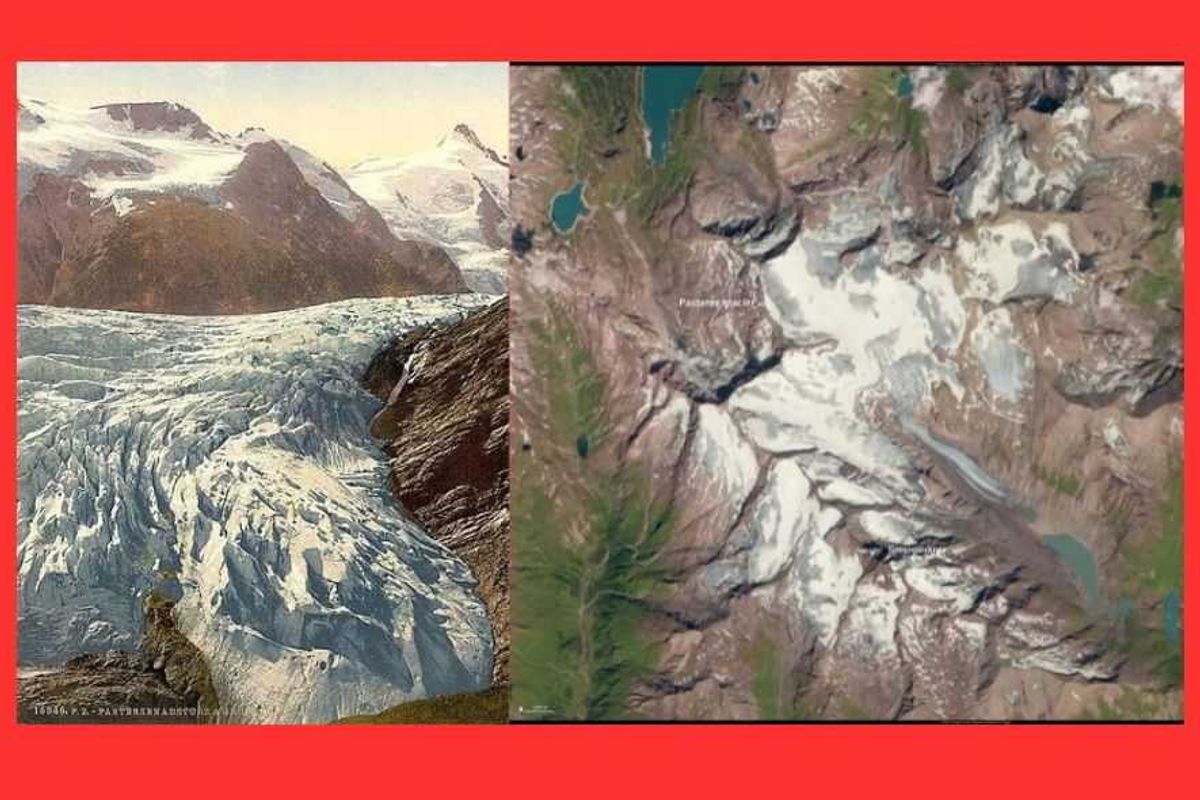This glacier was featured on a postcard in 1900. A satellite captured where it is today.
A lot has changed since 1900.
The Pasterze Glacier in a 1900 postcard and in March 2025
One hundred twenty-five years ago, the Pasterze Glacier in Austria's Eastern Alps was postcard perfect: Snowy peaks. Windswept valleys. Ruddy-cheeked mountain children in lederhosen playing "Edelweiss" on the flugelhorn.
But a lot has changed since 1900. Much of it has changed for the better. We've eradicated smallpox, Hitler is dead, and the song "Billie Jean" exists now. On the downside, the Earth has gotten hotter. A lot hotter. From June 2023 to May 2024, each subsequent month was the hottest ever recorded in the planet's history. July 2023 was the planet's hottest month—ever. And as of this writing, Yale Climate Connections declared June 2025 "the planet's third-warmest in history."
Unsurprisingly, man-made climate change has wreaked havoc on the planet's glaciers—including the Pasterze, which is Austria's largest. Just how much havoc are we talking about? Well, this is how the Pasterze Glacier looked in a 1900 postcard:

And this is how it looked in March 2025:

First measured in 1851, the glacier lost half of its mass between 1856 (when it first began receding) and the early 2000s. A marker placed in 1985 shows where the edge of the glacier reached just 40 years ago. You can still see the ice sheet, but just barely, way off in the distance. In between is...a big, muddy lake. The view from the glacial foot marker from 1995—just 10 years later—isn't much more encouraging. Even in just one year, 2015, the glacier lost an astounding amount of mass—177 feet, by some estimates.
Overall, it is estimated that the glacier has retracted by 980 feet since the park first opened in 1963.
Ice continues to melt daily, and while the dripping makes for a good photo, it's unfortunate news for planet Earth. Glacial melting is one of the three primary causes of sea-level rise. Pasterze is still technically the largest glacier in Austria and the Eastern Alps at approximately 6.2 miles. And even in its reduced form, Pasterze remains a significant tourist destination.
- YouTube youtu.be
According CREA Mont-Blanc, a research center for Alpine Ecosystems, the average temperature in the Alps has increased two degrees Celsius in the last 100 years—double the global average. It's not unreasonable to assume that that's why this mountain hut has been abandoned by the flugelhorn-playing children who once probably lived in it.
Is there anything we can do to stop the Pasterze Glacier from disappearing?
There are efforts underway to save Pasterze and other significant glaciers. However, Gerhard Lieb, the co-leader of the Austrian Alpine Club described the glacier's retreat as "unstoppable" with predictions that it and Austria's other major glaciers will be gone in as little as 45 years. It would take decades of meaningful counter climate change initiatives, with even the existing ones being too slow for meaningful action, "and the time is up,” Lieb said. “That means nothing can be done anymore.”
This article originally appeared 10 years ago. It has been updated with new information.

